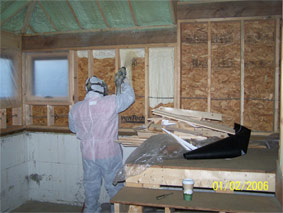Chemicals

Spray Foam Insulation
The major application for SPF is in the construction industry as a commercial roofing system and perimeter wall insulation material. Use of SPF for wall insulation in the residential housing sector is a rapidly growing market, due to the many energy saving and air/moisture barrier advantages over traditional fiberglass and cellulose insulation systems.
Rigid polyurethane foams are also used as insulation in buildings, on roofs, water heaters, refrigerated transport, and commercial and residential refrigeration where their insulation value, high strength, moisture resistance and durability are required. Polyurethane foams are also used for flotation, packaging, furniture, adhesives, architectural design, and cavity filling.
Polyurethane foams can be sprayed, poured, or injected into molds using special equipment. Polyurethane foams can also be mixed by hand and poured into cavities. This website will focus primarily on Sprayed Polyurethane Foam, better known as the acronym, SPF, and its many applications and markets.
SPF is produced by a chemical reaction when two liquid components are combined, an isocyanate, known as the “A” component, and a polyol resin, known as the “B” component. When the two liquids are mixed together (typically at a one-to-one ratio), a chemical reaction occurs creating rigid, or semi-rigid foam. The mixed liquid starts to react in seconds, expanding 20 to 30 times its liquid state (100 to 150 times for open cell foam). Once cured it solidifies and becomes polyurethane foam.
Studies have shown that as much as 40% of a building’s energy loss is due to heat loss, or gain, through walls, roofs and windows. SPF is an incredible material for roofing systems and thermal insulation with its excellent water resistance and ability to air-seal your home or building with R-values ranging to 6.5 to 7.0 per inch. This efficiency contributes to significant energy savings throughout the life of a building and benefits the owner allowing the use of smaller capacity cooling and heating equipment.

